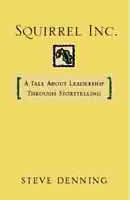 Stories have the power to ignite, educate, unify, lead, share values, and focus attention. We’re born to tell and listen to stories. Why are we shy to use them to help us in business?
Stories have the power to ignite, educate, unify, lead, share values, and focus attention. We’re born to tell and listen to stories. Why are we shy to use them to help us in business?
While I’ve already written of how to tell your marketing story, Stephen Denning writes about organizational storytelling. His book is a fable showing how can you use a story to help you inside your business.
Next time you’re tempted to use a PowerPoint slide show or present information for your business, consider instead crafting a story. It will no doubt take you longer to prepare your story, but the results can be dramatic. No glazed eyes staring at handouts or screens. Instead, people will be focused on you, listening and imagining.
The book’s story focuses around a squirrel company that needs to change its business model. It has been a company that helps squirrels bury nuts. But one visionary in the company wants the company to instead help squirrels store nuts. How the visionary learns to convince their peers, their boss, and eventually the board is the fable.
The book lists the high-value forms of organizational storytelling, so you can match the right type of story to achieve a certain result. Here’s a brief synopsis:
- To spark action
- The story must be true and focuses on a positive outcome
- Have people say: “Just think..” or “Just imagine…”
- To build trust
- Reveal some true strength/vulnerability from your past
- Have people say: “I didn’t know that about you”
- To transmit values
- Describe how leadership did something before
- You must walk the talk
- Have people say: “That’s clearly the right way…”
- To get people to work together
- Tell a story that others can relate to
- Have people say: “That reminds me…”
- To neutralize gossip
- Commit to tell the truth, but show the humor in the situation
- Have people question the gossip
- To share knowledge
- Tell the problem, setting, solution, and explanation
- Have people say: “We need to keep on eye on that…”
- To lead people
- Describe a positive outcome about the future
- Have people say: “When do we start?”
If you don’t feel comfortable telling stories to people, join a public speaking club to exercise your story-telling muscles (or take an improvisational acting class). Remember that you’re not trying to get people to buy tickets to hear you speak (yet) – you’re just trying to learn a new tool to communicate ideas with others.